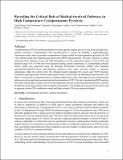| dc.contributor.author | Dong, Xiaorui | |
| dc.contributor.author | Ninnemann, Erik | |
| dc.contributor.author | Ranasinghe, Duminda S | |
| dc.contributor.author | Laich, Andrew | |
| dc.contributor.author | Greene, Robert | |
| dc.contributor.author | Vasu, Subith S. | |
| dc.contributor.author | Green Jr, William H | |
| dc.date.accessioned | 2020-08-14T21:18:29Z | |
| dc.date.available | 2020-08-14T21:18:29Z | |
| dc.date.issued | 2020-06 | |
| dc.identifier.issn | 0010-2180 | |
| dc.identifier.uri | https://hdl.handle.net/1721.1/126598 | |
| dc.description.abstract | Cyclopentanone (CPO) is a promising biofuel for spark-ignition engines due to its ring strain and high auto-ignition resistance. Understanding CPO decomposition is crucial for building a high-temperature combustion model. Here we present a comprehensive kinetic model for high-temperature pyrolysis of CPO with verified results from high-pressure shock tube (HPST) measurements. The time-histories of carbon monoxide (CO), ethylene (C₂H₄), and CPO absorbances over the temperature range of 1156–1416 K and pressure range of 8.53–10.06 atm were measured during current experiments. A corresponding detailed kinetic model was generated using the Reaction Mechanism Generator (RMG) with dominant unimolecular/radical-involved decomposition pathways from either previous studies or quantum calculations within the current work. The obtained model containing 821 species and 79,859 reactions exhibited a good agreement with the experimental results. In this study, the absorbance ratio between C₂H₄ and CO was used as an important factor to validate models and to prove that radical-involved bimolecular pathways were as significant as unimolecular decomposition of CPO. The rate of production (ROP) analysis showed H radicals play a major role in the decomposition, and the whole decomposition process could be divided into three stages based on the H radical concentration. The insights from present work can be used to generate a better CPO combustion model and help evaluate CPO as an advanced biofuel. | en_US |
| dc.description.sponsorship | Department of Energy (Grant DE-EE007982) | en_US |
| dc.publisher | Elsevier BV | en_US |
| dc.relation.isversionof | http://dx.doi.org/10.1016/j.combustflame.2020.03.001 | en_US |
| dc.rights | Creative Commons Attribution-NonCommercial-NoDerivs License | en_US |
| dc.rights.uri | http://creativecommons.org/licenses/by-nc-nd/4.0/ | en_US |
| dc.source | Prof. Green | en_US |
| dc.title | Revealing the critical role of radical-involved pathways in high temperature cyclopentanone pyrolysis | en_US |
| dc.type | Article | en_US |
| dc.identifier.citation | Dong, Xiaorui et al. "Revealing the critical role of radical-involved pathways in high temperature cyclopentanone pyrolysis." Combustion and Flame 216 (June 2020): 280-292 © 2020 The Combustion Institute | en_US |
| dc.contributor.department | Massachusetts Institute of Technology. Department of Chemical Engineering | en_US |
| dc.relation.journal | Combustion and Flame | en_US |
| dc.eprint.version | Author's final manuscript | en_US |
| dc.type.uri | http://purl.org/eprint/type/JournalArticle | en_US |
| eprint.status | http://purl.org/eprint/status/PeerReviewed | en_US |
| dspace.date.submission | 2020-08-12T23:47:45Z | |
| mit.journal.volume | 216 | en_US |
| mit.license | PUBLISHER_CC | |
| mit.metadata.status | Complete | |
